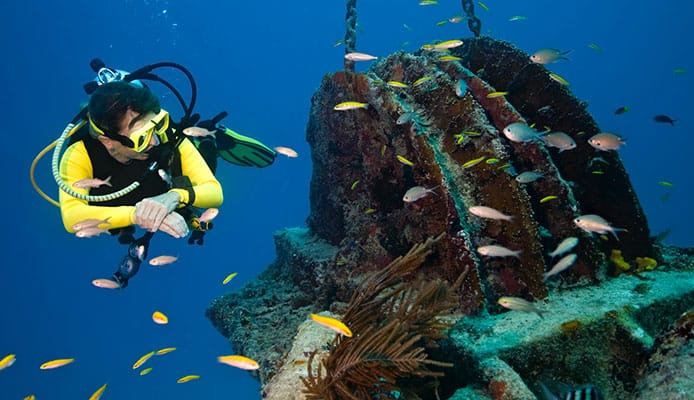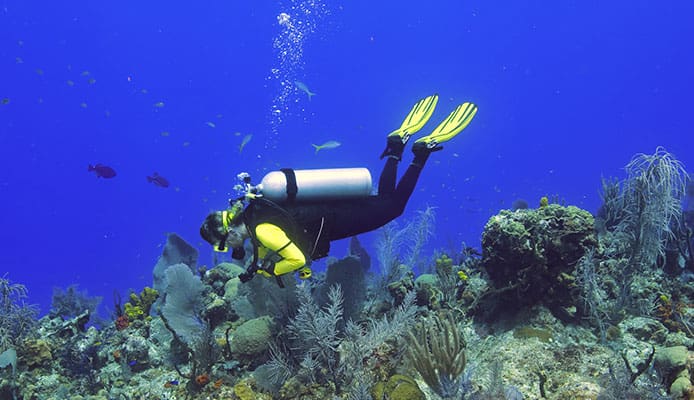
In this article, we’ll go through the basic stuff buoyancy-related. You’ll read about the positive and the negative buoyancy, how to use it, and much other stuff related to it.
No matter if you’re a swimmer, scuba diver, snorkeler, kayaker, or simply someone interested in water sports, you’ve probably heard the word buoyancy more than once. It is one of the most used words in the terms of water-related activities, essential when it comes to life jackets, swim vests, and overall important aspects of diving safety. It may be a bit confusing at first, but once you figure out the basics, the rest is not so complicated to adapt.
What Is Buoyancy?
Buoyancy is the word that describes the floating tendency of something, or, to simplify, it is the ability of something to remain on the water surface without sinking, but that’s not all. It is also used to describe whether something will float up, will it sink or will it remain in one place, moving upwards or downwards, neither. That means we have positive buoyancy, negative buoyancy, and neutral buoyancy.
Positive Buoyancy
Positive buoyancy happens when an object is lighter than the fluid. This means that the object will float because the force of buoyance is bigger than the weight of that object.
Negative Buoyancy
Negative buoyancy occurs when some object is denser than the fluid it moves through. This means that the weight of that object is bigger than the buoyant force, so that object will sink. The best examples of these two types of buoyancy are fresh water and saltwater. Swimming through the freshwater is much easier but it also takes more effort to remain at the surface, compared to the saltwater where the density will keep the swimmer’s body above the surface.
Neutral Buoyancy
Neutral buoyancy represents the type of buoyancy where the weight of the object is equal to the fluid it moves through. This type of buoyancy means that the object will be able to move through the water not just up or down, but also forward and backward.
The History Of Buoyancy
The history of buoyancy goes to ancient Greek and the scientist, Archimedes of Syracuse. The legend says that Hiero of Syracuse, the Greek ruler, wanted to know if the goldsmith has cheated on him when gave him his crown. He gave Archimedes gold and silver to figure out if the crown was made of gold or not. Archimedes, according to the story, couldn’t find the solution for some time, until one day he stepped into the hot tub. Then he suddenly jumped out of it and started running towards the castle, screaming “Eureka!” which means “I’ve found it!”
How did he do it? It is actually quite simple – he spotted the water rising when he entered the hot tub, and he figured out that the same thing will work for the crown, as well – all he had to do is to sink the crown into the water, then to find the corresponding amount of silver and gold that will reach the same water level. Thus, the buoyancy was born, and he used this knowledge to work on Archimedes’ principle – The upward buoyant force is equal to the weight of the fluid the object is moving through.
Buoyancy in Act – How Does It Work?
When an object enters the water, it moves to make a place for that object. For instance, if to take a bowl and fill it with water, then take a brick or a rock and place it in that bowl. You’ll see the amount of liquid spilling out of the now overflowed bowl. The volume of water that has been spilled is equal to the volume of the rock or the brick that was placed inside.
What follows is this – the water will try to fill that space now occupied by that object. As it pushes around that object, it is pressuring it, so that object is being pushed up by a force we call – buoyant force.
Will It Sink Or Will It Float – The Archimedes’ Principle
To learn will something float or will it sink you’ll have to use the above-mentioned Archimedes’ principle. One of the greatest mathematicians in the history of the world stated that two forces factor in how something will act in the water:
- Gravity and the object’s weight are the force that pushes the object down. The heavier and denser the object, the stronger the gravity and the more likely outcome of sinking – negative buoyancy.
- Buoyancy, also known as buoyant force, is the force that pushes the object up. The lighter and less dense the object, the more likely it will remain on the surface – positive buoyancy.
So, to see whether will something float or not, you’ll have to know which force is the stringer – the buoyancy or the gravity. If the buoyancy is greater than the gravity, it will float and vice versa – if the gravity prevails, it will sink.
To learn the weight of an object you could simply put it on a scale, but learning the buoyant force is a bit more… well, wet.
The easiest way to learn this is to take the object, sink it into the bowl filled with water, gather what has been spilled, and weigh it. You could also use Archimedes’ way:
- Fill the bowl to some point and mark it.
- Measure the weight.
- Add the object.
- Measure the weight.
- See how much the water level has risen and marked it.
- Empty the bowl, and then fill it with the amount of water between the two markers.
- Measure the weight. The value should be the same as the one you’ll get when you subtract the second weight value from the first weight value.
The Diving Buoyancy
For a successful diving session, you’ll have to learn how to sink until you reach the depth you want, and then to remain neutrally buoyant until you head back to the surface. While it is not possible to naturally change the buoyancy at will, it can be done with the help of an inflatable jacket or a buoyancy control device – BCD.
By inflating the BCD the buoyancy will increase because more water will be displaced, and the opposite – by deflating the BCD the buoyancy will decrease because less water will be displaced.
Scuba Diver’s Buoyancy Factors
To successfully control your dive and to be fully prepared you’ll have to know what factors affect the buoyancy.
- Buoyancy Control Device (BCD) is used to change the amount of water the diver displaces, allowing every individual to change the buoyancy by the needs. This is the only part of the diver’s equipment with the ability to change the weight and the volume.
- Weights are used to help divers overcome positive buoyancy. They help the diver move down through the water, and keep the diver under the water during the dive.
- Exposure protection like a drysuit or a wetsuit without an exception provides positive buoyancy. The wetsuit has several air bubbles in the neoprene, while drysuits work the way they trap some amount of air that surrounds the diver. The ticker the suit, the more buoyant it will be.
- Diving Gear affects the overall buoyancy of each part of the equipment individually. The lighter equipment you use, the bigger positive buoyancy will be, and the other way around – the heavier the equipment, the less additional weight you’ll need.
- Air Tanks Pressure also carries some weight. Although the weight and the volume of the tank itself remain the same, the amount of the air trapped inside empties with each breath, so it becomes lighter and lighter, which also affects buoyancy.
- Air In Your Body also has its own part in the buoyancy level. During the breathing process, your lungs expand and compress. While you inhale the lungs spread and they contribute to the positive buoyancy, and the opposite – during the exhaling, the lungs decrease and the buoyancy becomes a bit more negative. This is why in diving schools the students are being taught to exhale when they start to descent to make it easier.
- Buoyancy in saltwater and freshwater is also different. The salinity of the water is one of the biggest things that influence buoyancy. The salt dissolved in the water makes it heavier than the freshwater. For a clearer picture – when you submerge an object in fresh and in saltwater and then you measure the weight of those two glasses of water, you’ll find out that the saltwater is heavier, while the amount will remain the same.
This means the buoyancy is way bigger in saltwater, so you’ll need more weight.
You might also like: Best Full Face Scuba Masks
Can Too Much Weight Be A Problem?
Although you’ll need weight to successfully sink and stay under the surface if you use too much it could make the buoyancy control way harder. To avoid this problem, it is recommended to test your equipment and find the right weight scale before you enter for your first dive. It is also recommended to learn how to improve buoyancy control.
Globo Surf Overview
We’ve been through the history of buoyancy, the way it works, how to determine will something float or will it sink… Also, you know what factors could affect it. Now with all that knowledge, you’re ready to get the diving equipment that will fit you the most for your next diving adventure


